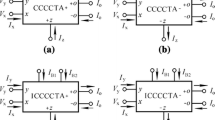Abstract
In this paper, we show how some basic building blocks for active-RC circuit design, such as amplifiers, impedance converters and simulated inductance circuits, may be synthesised in a systematic way by expansion of their port admittance matrices. The circuit topology emerges from the synthesis procedure, allowing all possible implementations to be identified and explored. Nullors representing ideal op-amps and transistors are represented within the nodal admittance matrix of a synthesised circuit by linked infinity parameters. In nodal admittance matrices describing ideal circuits synthesised, the replacement of linked infinity parameters by finite parameters provides a seamless transition to non-ideal analysis and practical circuit design.
Similar content being viewed by others
References
W.-K. Chen (Ed.), The Circuits and Filters Handbook, CRC-IEEE Press, 1995.
S.K. Mitra, Analysis and Synthesis of Linear Active Networks, John Wiley, 1969.
L.T. Bruton, RC-Active Circuits, Prentice-Hall, 1980, ISBN 0-13-753467-1.
R. Yarlagadda and F. Ye, “Active RC synthesis using nullators and norators,” IEEE Trans on Circuit Theory, vol. CT-19, no. 4, pp. 317–322, 1973.
T. Yanigaswa and N. Kanbayashi, “Realisation of arbitrary conductance matrix using operational amplifiers,” in Procs 1976 IEEE International Symposium on Circuits and Systems, Munich, April 1976, pp. 532–535.
J.K. Stevenson, “Network synthesis by admittance matrix expansion,” in Procs IEE Colloquium on Electronic Filters, London, ISBN 0-8529-6189-8, June 1978, pp 5–9.
J. Vlach, Basic Network Theory with Computer Applications, Van Nostrand Reinhold, 1992.
D.G. Haigh and P. Radmore, “Systematic synthesis method for analogue circuits-Part I: Notation and synthesis toolbox,” in Procs 2004 IEEE International Symposium on Circuits and Systems. Vancouver, May 2004, pp. 701–704.
D.G. Haigh, F.Q. Tan, and C. Papavassiliou, “Systematic synthesis method for analogue circuits—Part II: Active-RC circuit synthesis,” in Procs 2004 IEEE International Symposium on Circuits and Systems, Vancouver, May 2004, pp. 705–708.
A.C. Davies, “Nullator-norator equivalents for controlled sources,” in Proc. IEEE, vol. 55, May 1967, pp. 722.
P. Kumar and R. Senani, “Bibliography on nullors and their applications in circuit analysis, synthesis and design,” Analogue Integrated Circuits and Signal Processing, vol. 33, no. 1, pp. 65–76, 2002.
D.G. Haigh, “Symbolic active-RC circuit synthesis by admittance matrix expansion,” accepted for 2005 IEEE International Symposium on Circuits and Systems, Kobe, May 2005.
D.G. Haigh, F.Q. Tan, and C. Papavassiliou, “Systematic synthesis of analogue circuits—Part III: All-transistor circuit synthesis,” in D.G. Haigh et al., (Eds.), Procs 2004 IEEE International Symposium on Circuits and Systems, Vancouver, May 2004, pp. 709–712.
P. Corbishley and D.G. Haigh, “Rules for systematic synthesis of all-transistor analogue circuits by admittance matrix expansion,” accepted for 2005 IEEE International Symposium on Circuits and Systems, Kobe, May 2005.
Author information
Authors and Affiliations
Additional information
Now with the Singaporean Armed Services.
David Haigh was born in Middlesex, England, in 1946. He obtained the B.Sc. degree in Electrical Engineering from Bristol University in 1968 and in 1976 he received the Ph.D. degree from the University of London. From 1968 until 1972 he worked under Dr. Wolja Saraga first at the GEC Hirst Research Centre and then, from 1972, at Imperial College London where he worked on microelectronic high precision filters. In 1987 he joined the staff of the Electronic and Electrical Engineering Department of University College London, where he studied analogue integrated circuit design with particularly interest in high frequency circuits. In 2003 he re-joined the Department of Electrical and Electronic Engineering at Imperial College London, where his interests broadened to include general approaches for analogue circuit synthesis. He is editor-in-chief (Europe) of the Analog Integrated Circuits and Signal Processing Journal.
Fang Qun Tan graduated with a B.Eng. degree from Imperial College London in 2002. He then studied for the M.Sc. in Analogue and Digital integrated Circuit Design at Imperial College and graduated with distinction in 2003. His M.Sc. project was on the subject of systematic synthesis methods for analogue circuits. At present Fang Qun is with the Singapore Armed Services.
Christos Papavassiliou was born in Athens, Greece, in 1960. He received the B.Sc. degree in physics from the Massachusetts Institute of Technology and the Ph.D. degree in Applied Physics from Yale University. He has worked on monolithic microwave integrated circuit (MMIC) design and measurements at FORTH in Crete, Greece, and has been involved in several European and regional projects on GaAs MMIC technology. In 1996 he joined Imperial College London, where he is currently a Senior Lecturer. He currently works on SiGe technology development as well as instrumentation and substrate noise coupling in mixed mode integrated circuit design. He has 30 publications.
Rights and permissions
About this article
Cite this article
Haigh, D.G., Tan, F.Q. & Papavassiliou, C. Systematic Synthesis of Active-RC Circuit Building-Blocks. Analog Integr Circ Sig Process 43, 297–315 (2005). https://doi.org/10.1007/s10470-005-1609-y
Received:
Revised:
Accepted:
Issue Date:
DOI: https://doi.org/10.1007/s10470-005-1609-y




